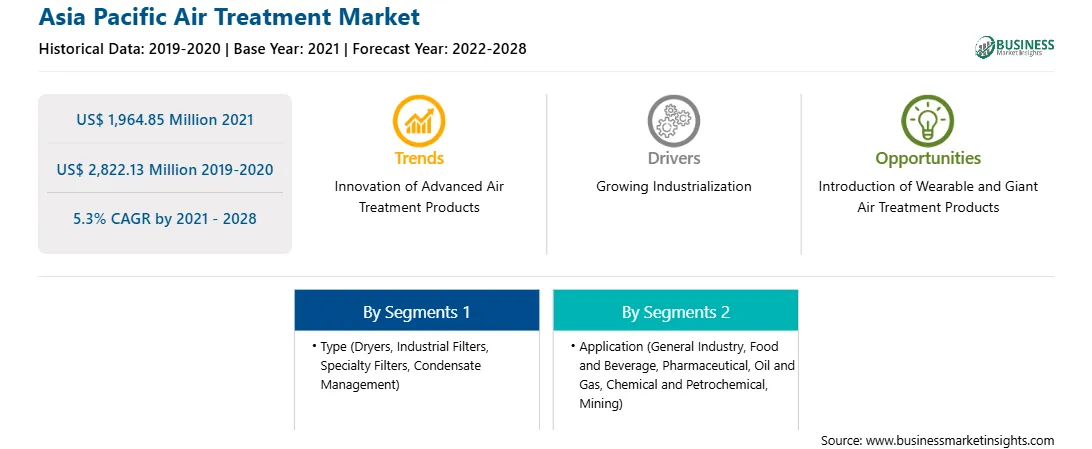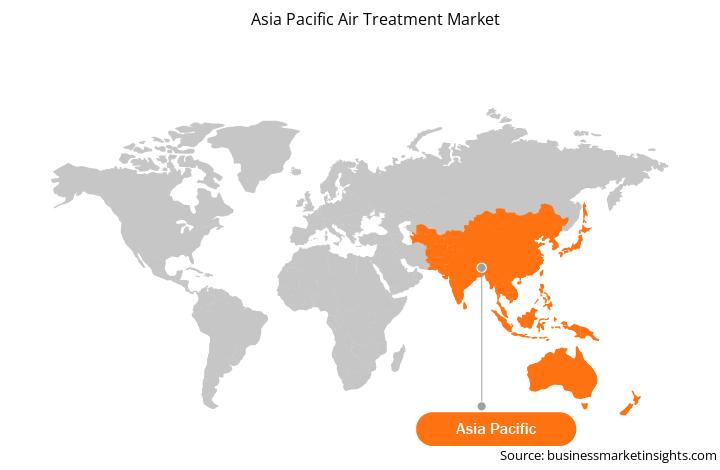Air pollution is a major cause of morbidity and mortality across the region. China is the world's fastest-growing and largest developing country, and it reports one of the highest air pollution-related mortality rates in the world due to the worsening air pollution levels. In 2019, ambient particulate matter pollution was ranked as the fourth-leading cause of the loss of years of life among people in China. As a result, the necessity for air treatment has been a key focus of governments worldwide, contributing to the air treatment market expansion.There is substantial epidemiological evidence that air pollution is harmful to human health and is linked to respiratory disorders such as chronic obstructive pulmonary disease (COPD). The exacerbation of existing symptoms has resulted in reduced lung functioning and increased hospitalization and mortality rates, which can be classified into short- and long-term effects. In the long term, the combined effect of several contaminants might lead to catastrophic events. As a result, the demand for air treatment products is increasing continuously. Various air pollution control technologies such as catalytic recuperative oxidizer (CATOX), thermal recuperative oxidizer, and regenerative thermal oxidizers (RTOs) are rapidly growing in the air treatment market. These technologies destroy hazardous air pollutants (HAPs) and odorous emissions discharged from various industrial processes via thermal oxidation and heat recovery at substantially lower temperatures. Growth in energy-efficient air pollution control technologies that help minimize operating costs and the air treatment system's overall energy consumption is enhancing the market growth across the region. The availability of multiple designs for faster installation and greater system flexibility for applications with large flow, low concentration process streams, and a wide range of temperature and contaminant capability is significantly driving the air treatment market.
With new features and technologies, vendors attract new customers and expand their footprints in emerging markets. This factor is likely to drive the Asia Pacific air treatment market at a substantial CAGR during the forecast period.
Strategic insights for the Asia Pacific Air Treatment provides data-driven analysis of the industry landscape, including current trends, key players, and regional nuances. These insights offer actionable recommendations, enabling readers to differentiate themselves from competitors by identifying untapped segments or developing unique value propositions. Leveraging data analytics, these insights help industry players anticipate the market shifts, whether investors, manufacturers, or other stakeholders. A future-oriented perspective is essential, helping stakeholders anticipate market shifts and position themselves for long-term success in this dynamic region. Ultimately, effective strategic insights empower readers to make informed decisions that drive profitability and achieve their business objectives within the market.

| Report Attribute | Details |
|---|---|
| Market size in 2021 | US$ 1,964.85 Million |
| Market Size by 2028 | US$ 2,822.13 Million |
| Global CAGR (2021 - 2028) | 5.3% |
| Historical Data | 2019-2020 |
| Forecast period | 2022-2028 |
| Segments Covered |
By Type
|
| Regions and Countries Covered | Asia-Pacific
|
| Market leaders and key company profiles |
The geographic scope of the Asia Pacific Air Treatment refers to the specific areas in which a business operates and competes. Understanding local distinctions, such as diverse consumer preferences (e.g., demand for specific plug types or battery backup durations), varying economic conditions, and regulatory environments, is crucial for tailoring strategies to specific markets. Businesses can expand their reach by identifying underserved areas or adapting their offerings to meet local demands. A clear market focus allows for more effective resource allocation, targeted marketing campaigns, and better positioning against local competitors, ultimately driving growth in those targeted areas.

Asia Pacific Air Treatment Market Segmentation
The Asia Pacific air treatment market is segmented based on type, application, and country. Based on type, the market is segmented into dryers, industrial filters, specialty filters, and condensate management. In 2020, the industrial filters segment held the largest share of the market; and the dryers segment is expected to register the highest CAGR during the forecast period. Based on dryers, the market is segmented into refrigerant, adsorption, membrane, and deliquescent. In 2020, the refrigerant segment held the largest share; and the membrane segment is expected to register the highest CAGR during the forecast period. Based on industrial filters, the market is segmented into adsorber/oil vapor removal, coalescing, particulate, and moisture separators. In 2020, the particulate segment held the largest share; and the coalescing segment is expected to register the highest CAGR during the forecast period. Based on specialty filters, the market is segmented into stainless steel, sterile, silicone free, high pressure, high temperature, antibacterial, and absolute filters. In 2020, the high temperature segment held the largest share of the market; and the sterile segment is expected to register the highest CAGR during the forecast period. Based on specialty filters, the market is segmented into aftercoolers, oil water separators, and drains. In 2020, the drains segment held the largest share of the market; and the aftercoolers segment is expected to register the highest CAGR during the forecast period. Based on application, the market is segmented into general industry, food and beverage, pharmaceutical, oil and gas, chemical and petrochemical, and mining. In 2020, the pharmaceutical segment held the largest share of the market; and the general industry segment is expected to register the highest CAGR during the forecast period. Further, based on country, the Asia Pacific air treatment market is segmented into Australia, China, India, Japan, South Korea, and the Rest of APAC. In 2020, China held the largest market share; and India is expected to grow at the fastest CAGR during the forecast period.
Beko Technologies; Donaldson Company, Inc.; Friulair Srl; Ingersoll Rand Inc.; KAESAR KOMPRESSOREN; Mikropor; OMEGA AIR d.o.o. Ljubljana; ORION Electronics Ltd.; SPX FLOW, Inc.; Xebec Adsorption Inc.; Guangzhou Hanyue Purification Technology Co.; and Hongrijia Depurate Facility Science and Technology Co., Ltd are among the leading companies in the Asia Pacific air treatment market.
The Asia Pacific Air Treatment Market is valued at US$ 1,964.85 Million in 2021, it is projected to reach US$ 2,822.13 Million by 2028.
As per our report Asia Pacific Air Treatment Market, the market size is valued at US$ 1,964.85 Million in 2021, projecting it to reach US$ 2,822.13 Million by 2028. This translates to a CAGR of approximately 5.3% during the forecast period.
The Asia Pacific Air Treatment Market report typically cover these key segments-
The historic period, base year, and forecast period can vary slightly depending on the specific market research report. However, for the Asia Pacific Air Treatment Market report:
The Asia Pacific Air Treatment Market is populated by several key players, each contributing to its growth and innovation. Some of the major players include:
The Asia Pacific Air Treatment Market report is valuable for diverse stakeholders, including:
Essentially, anyone involved in or considering involvement in the Asia Pacific Air Treatment Market value chain can benefit from the information contained in a comprehensive market report.